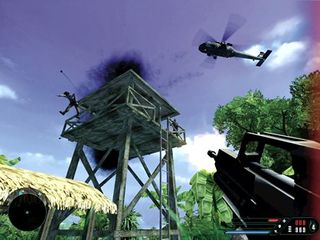In 2001, Grand Theft Auto III moved the series into 3D, becoming a true worldwide phenomenon in the process and spawning an entire genre of imitators from Just Cause to Saint’s Row. “It’s frustrating though,” adds Statham, “that if you consider GTA IV and the stuff they’ve crammed into Liberty City which allows for a phenomenal open-world gaming experience, that’ll keep most gamers filled with wonderment for 100-plus hours, you still see comments on forums saying that graphically it’s ‘not up to much’. “That kind of attitude is a real problem for open-world game developers because, whether we like it or not, looks sell games.”

Above: Far Cry perfected the ‘action bubble’ feeling of freedom
In 2008, there are a glut of freeform shooters on the horizon – Ubisoft’s Africa-based sequel to Crytek’s original, Far Cry 2, GSC Game World’s STALKER prequel Clear Sky, Bethesda’s Fallout 3 and Bohemia Interactive’s Armed Assault 2 – and all these games are pushing the technology of open-world gaming into new territories. In Armed Assault 2, for example, the development team is adding role-playing elements to the military simulator format, including a dynamic conversation system. “If an NPC witnesses something in the game, even if it’s something the gamer doesn’t see themselves, then the NPC will remember,” says Statham. “If, for example, an enemy squad moves through a town 20 miles from where the gamer is, the NPCs in the town will observe this.
“When you enter the town a couple of hours later, you can ask them if they’ve seen any enemy presence, and they’ll tell you that they saw an enemy squad moving west about two hours ago – if they’re friendly to you. Perhaps they know that you killed a civilian in the next town across, so they won’t tell you anything at all, or they’ll lie to you to set you up for an ambush by the enemy...”
Ed del Castillo believes that improving AI is one of the most important areas for enhancing open-world gaming. “The industry is talent-starved – we really need great coders and multi-dimensional people, as in order to have great AI, you need a person who can create systems that simulate life. That person needs to be someone introspective, philosophical, and a viewer of people – working out how to fake salient features in people.” Bethesda’s Howard agrees: “I think it’s become common for developers to be able to put lush scenery together, but creating other characters that can react to what you do in a believable and compelling way, is still very difficult. We have a long way to go.”

Above: Rise of the Argonauts, whose creator has a few ideas on the art of free-form
Then of course, there are the MMOs – millions of individuals creating their own unique personalities, guilds and live events in huge, persistent game worlds. There are role-playing games including EverQuest II and the mighty World of Warcraft; community-driven racing games such as rFactor; MMO shooters including PlanetSide and the forthcoming Huxley; and the next generation of online urban adventures withAPB, from Realtime Worlds, a company set up by Dave Jones, creative director of the original Grand Theft Auto. Linear games are so last century – the future, it appears, is wide open. “We have the opportunity to show variety of choice, to let the player play the game he or she wants to play, and experience what they want to experience,” says del Castillo. “The future of videogames isn’t in storytelling, but in story-playing.”
Jul 11, 2008
